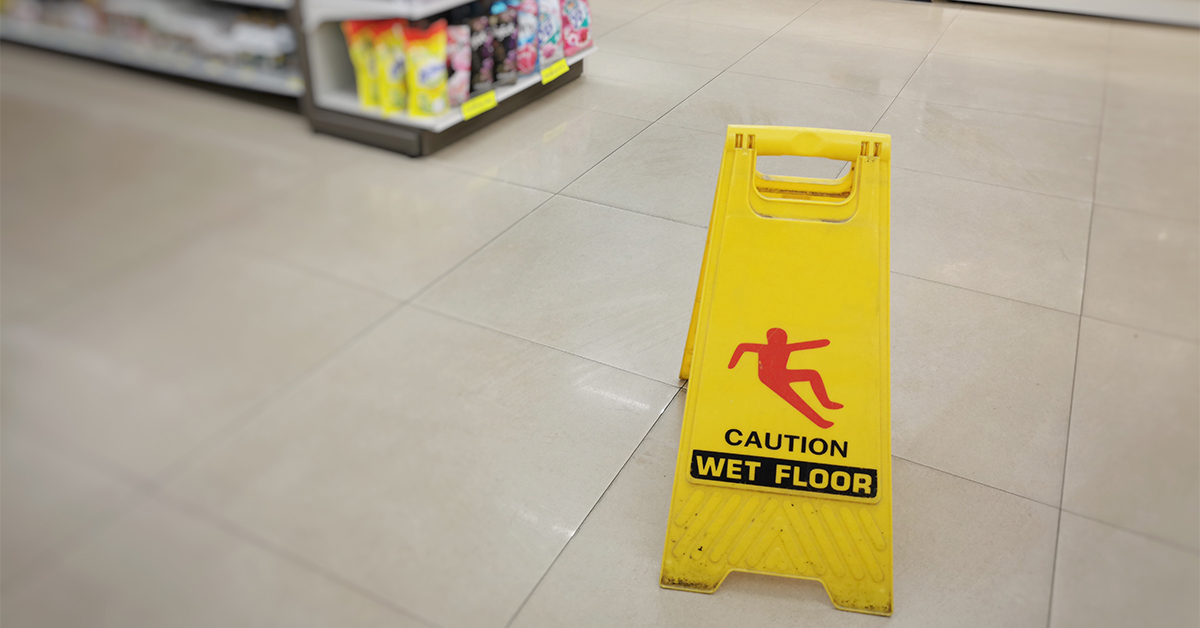Staying Safe on the Job: Work Safety Tips for Retail Merchandisers
by

While nobody is ever going to mistake it for trawling for cod on an Arctic fishing boat, or suiting up as a rodeo clown, working as a Retail Merchandiser does have its own inherent risks. Ladder and step stool injuries, products toppling from high shelves, and of course the inevitable slips and falls can all lead to serious injuries for you, a co-worker or even a customer in the wrong place at the wrong time. The good news is, all of these dangers are quite preventable when you follow basic work safety protocols. Let’s outline them now.
Slips and Falls—How to Reduce the Chance of Them Occurring
Let’s start with the obvious fact: people slip and fall all the time. You can trip over your own feet—it happens to everybody. And while we cannot eliminate slips and falls from your life, we can teach you the steps to dramatically reducing them on the job. Here’s how:
Make sure your space is free from debris. To be a successful Retail Merchandiser, you’re going to have to learn how to manage clutter. Stray products lying on the floor in the middle of an aisle is an invitation to disaster. Make sure the space you’re working in is always clear. Don’t leave products on the floor. One great way to stay organized—if the store management okays its use—is a shopping cart. It keeps you organized, and keeps products and debris off the store floor. Make sure you check with the store manager first. Some retailers as a matter of policy prohibit the use of shopping carts during a reset. They want all carts used for customers. But if your retail location is fine with it (and many are) then you’ll quickly see how helpful a shopping cart can be.
Look out for leaks. Many retail spaces can have leaky spaces, so make sure there’s no dripping from the ceiling. If you see a leak, let the store manager know ASAP. If you’re working with a product such as detergent, be extra careful. Detergent spills are notoriously dangerous, and are basically an accident waiting to happen. When spills occur, quick communication is critical! Talk with your store manager to let them know about the spill. Either they will be able to provide you with everything you need to remedy the situation, or they will take care of it themselves. But the key is to act fast, before someone gets injured.
Always let the store manager know about spills or leaks. But don’t leave the area of the spill to do it. Your most important job is to make sure customers don’t slip and fall.
Staying Safe on Ladders and Step Stools
You don’t need to be Stephen King to envision all the ways you could get hurt on a ladder. A quick google is more than enough to reveal a range of accidents that could befall you if you’re not careful. The workplace calls for extra caution when using a ladder, because you risk injuring store employees and customers.
As a rule of thumb, when you’re on a ladder, you want to make sure everything is as safe as possible. That means being extra cautious:
- Make sure the ladder is not broken or damaged.
- Don’t ever use the top of the ladder as a step.
- And—though we probably don’t need to say it—never fasten ladders together to create a giant superladder.
This helpful infographic goes into more detail about workplace safety with ladders. You find even more safety tips here. Though they’re not as dangerous as ladders, stepstools also need to be used with caution. You can find stepstool workplace safety tips here.
Shelves, Stacking and Safety
As a Retail Merchandiser, you get to see a lot of shelves. You’ll work on shelf units of all shapes and sizes. And while the work itself is straightforward, there are serious precautions that must be followed to ensure safe retail environment for customers, employees, and you. Here are some rules to follow:
-
Don’t overcrowd the shelves. A crowded and cluttered shelf is not appealing to the eye. And when that shelf is up high, it can be incredibly dangerous as well. Items falling from tall shelves onto people is one of the most serious risks in a retail environment. Make sure all the items have plenty of room and are not placed too close together.
-
Make sure the shelves are fastened. Wobbly, unsteady shelves are never okay. Shelving units need to be fastened or securely anchored to prevent accidents. If you come across a shelf or display unit that seems like it could topple over, alert the manager right away.
-
Don’t’ climb shelves to access products. Unless you’re a Monitor Lizard, climbing up store shelves is extremely dangerous. Nothing good comes from it, and quite often it leads to serious injury. Use a ladder or stepstool instead.
- Stick to the planogram. Your planogram is designed to make the products look eye-catching, and secure. Make sure you closely follow the planogram when arranging shelves.
Remember, talk to your zone lead if you are concerned about safety hazards in one of your locations. Have any tips or best practices Have we left anything out? Let us know.
